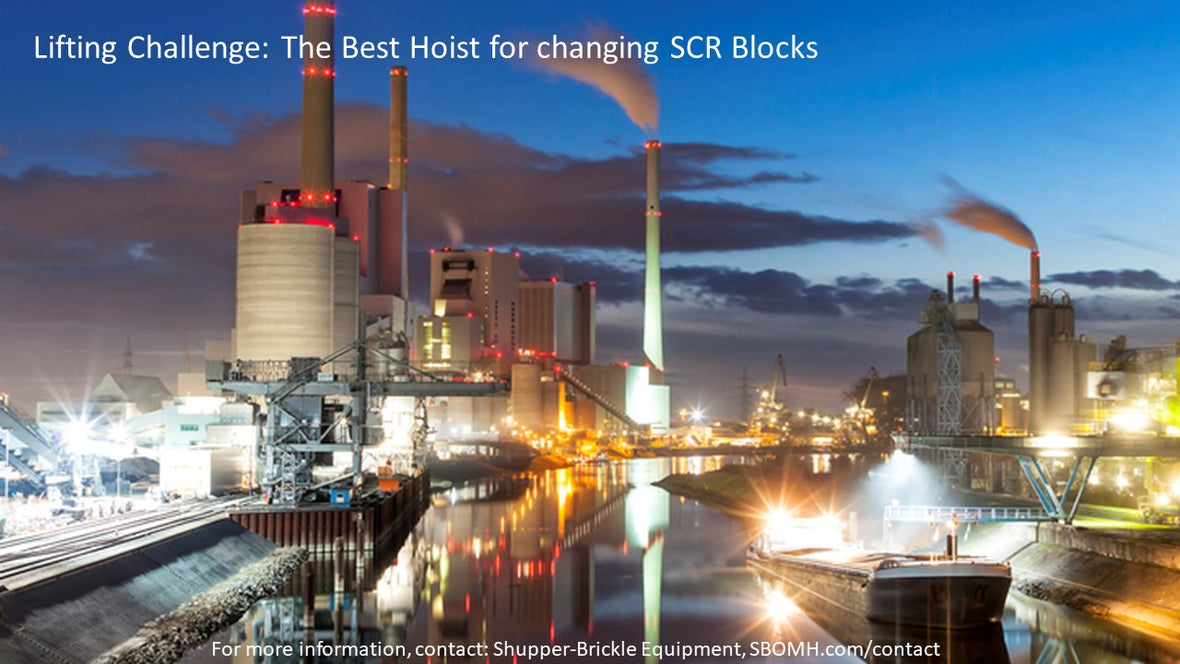
The Best Hoists for Power Plants to Lift SCR Blocks
Andrew T. Litecky
Welcome to The Hoist Guy's Blog, where our resident Hoist Guy Andrew T. Litecky shares his knowledge and experience of many years in the overhead material handling industry.
For today’s lifting challenge: Lifting Selective Catalytic Reduction blocks that weigh about 4000 lbs, from heights up to 90 feet, but only every five years.
Power Plant SCR Block Hoists
Compliance with the Clean Air Act includes cleaning the emissions of fossil fuel power plants using SCR (selective catalytic reduction) blocks to remove the NOx from emissions. Selecting the correct hoist to lift the blocks is paramount to their quick installation and change out. SCR blocks are installed at plant start-up and remain in place for approximately five years. After that, they need replacing.
During start-up installation, the clean SCR blocks are raised from grade to the working level, typically 80’ to 90’ and one at a time using a hoist. The blocks typically weigh 2000 lbs each. After scrubbing the emissions for about five years, it is time to remove and replace each block, which now weighs around 4000 lbs. During the start-up and change out the SCR hoist will work around the clock. Configuring the hoist properly is essential to a successful start-up with no delays.
What’s the best hoist for this job?
Any piece of equipment that goes from long periods of zero use to sustained periods of continuous use must be well-made and durable. For this critical application, it is important to work with a reliable hoist. Here are a few considerations when choosing the hoist:
- To start, buyers should look for an electric wire rope hoist with a few modifications.
- Adders such as synthetic gearcase lube and stainless-steel, rotation-resistant wire rope will bolster the hoist’s weather resistance and longevity.
- Meanwhile, a dual speed hoist makes the most of this job. We recommend a hoisting speed of 39/13 feet-per-minute, including a slow speed for delicate picking and placing as well as a fast speed to save time on long up and down lifts and lowers.
- For safety, an overload device protects the equipment and operator by preventing the hoist from picking dangerous overloads.
- Meanwhile, a geared upper and lower limit with a final upper limit switch will keep the long lift hoist from exceeding the hook block travel limit.
- For hoist controls, use across the line starters for the hoist, trolley and mainline contactor with a standard 6-button pendant.
- Avoid using VFD’s outdoors, unless the control enclosure is climate controlled.
- If the area is hazardous (i.e. Class 1, Groups C&D, Division II outdoors) then the control enclosure should be NEMA 7/4X with intrinsically safe pendant and limit switches.
A more detailed list of the requirements is available in our free SCR hoist specification.
Hoist Storage During the Period of Non-Use
The five-year storage between SCR change outs can be very damaging to the hoist. Parking the hoist under a Shupper-Brickle Hoist Shelter keeps the weather elements from damaging the hoist. We also recommend regular exercise for the hoist. At least once a month, put power to the hoist, run the trolley several times along the monorail and at the drop zone end, with a small load, lower to grade and raise to upper limit. Once per year, even during the non-use years, have an OSHA inspection performed. This OSHA inspection should include opening the electrical panel and checking for moisture and corrosion.
Whatever hoist brand you use, configuring the hoist properly will allow operators to work efficiently to change out the SCR Blocks. Maintaining the hoist will guarantee that when the hoist is needed, it will be ready to use, every five years, with no down time during the critical shutdown times.
Contact The Hoist Experts!
Since 1969, Shupper-Brickle Equipment has provided overhead cranes, hoists, and engineering. Our experienced team provides expert advice on overhead material handling equipment, solves unusual lifting problems, and offers equipment for specialty industries. Contact us for more information.


